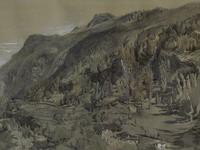John Ruskin and the Geographical Imagination
Denis Cosgrove selects works from Ruskin’s Teaching Collection and reveals a poetry of landscape that inspired geographical learning a century ago.

For Ruskin, JMW Turner was the greatest student of landscape, whose images, based on the most intense observation, captured the poetic truth of natural forms and processes. Ruskin’s earliest continental travels were in search of the landscapes Turner had captured, especially in his vignettes for Samuel Roger’s poem Italy. Turner remained the model to which Ruskin’s drawing students should strive but never hope to attain in their studies of landscape.
Watercolour (copy of JMW Turner vignette for Roger’s Italy by William Ward)
'For expression of sunlight and air, with a few touches on white paper, I never saw the like of the original. The drawing of the ruined fragment of temple is admirable practice. Such work is constantly wanted in Italian subjects.' (21:213)
Watercolour (copy of JMW Turner vignette for Roger’s Italy by William Ward)
'It is impossible to explain the exquisite qualities of taste which Turner shows in these compositions, and sympathy with the characters of the Italian landscape, which in him was quite as passionate and far more pure than the sentiment either of Byron or Shelley.' (21:213-214)
References
All references to Ruskin's writings are taken from The Works of Ruskin, Library Edition, 39 volumes, edited by E.T. Cook and Alexander Wedderburn, George Allen, London, 1903-1912 and given by volume number and page.






